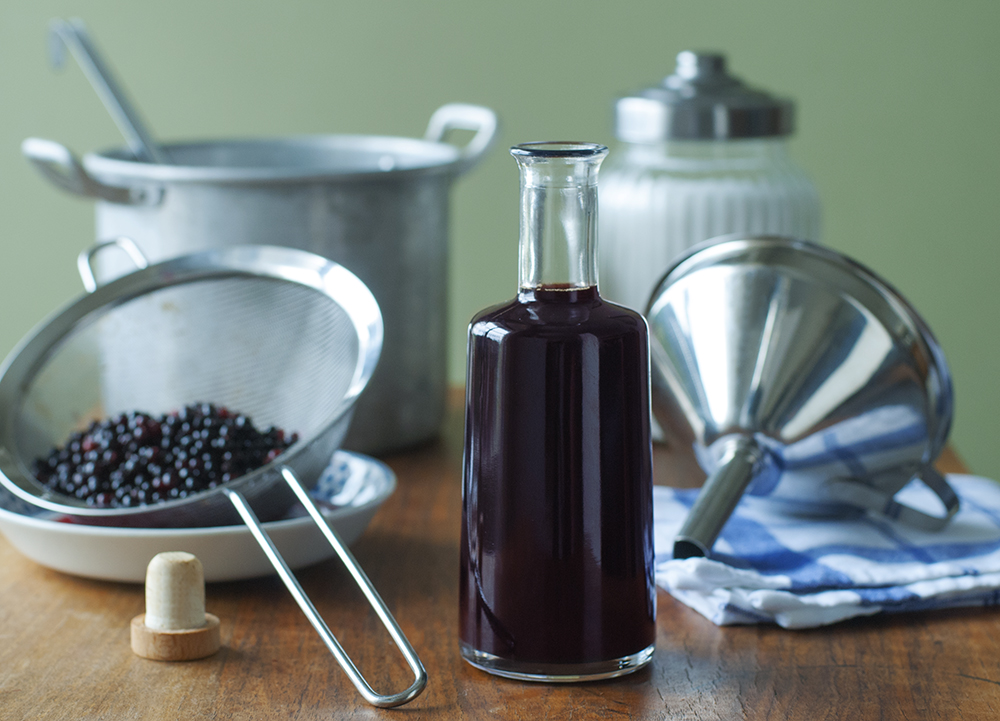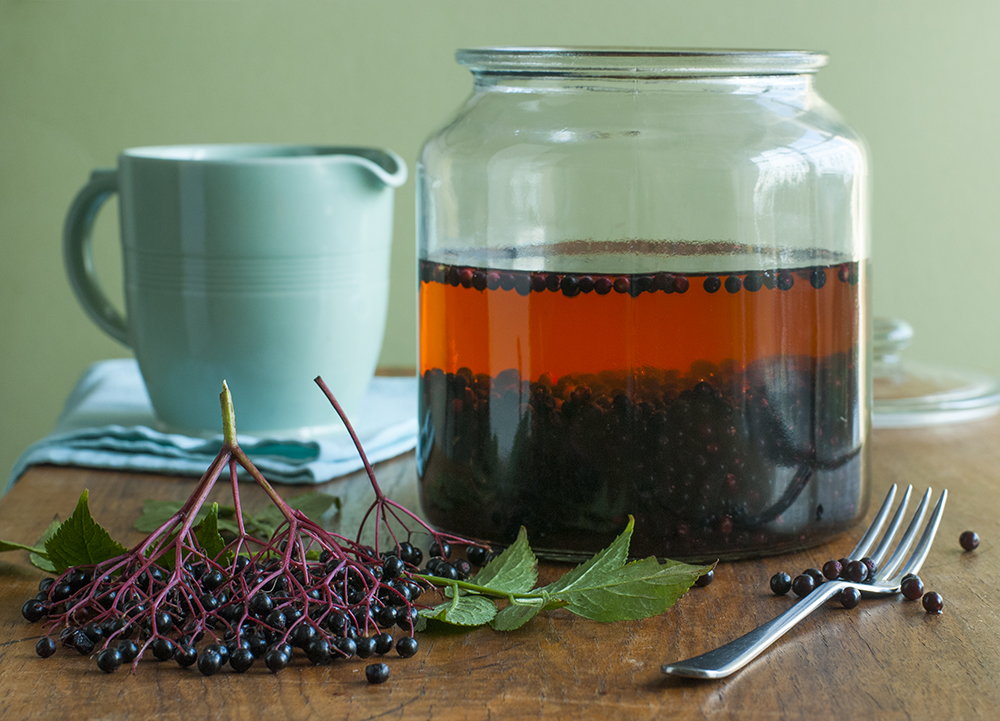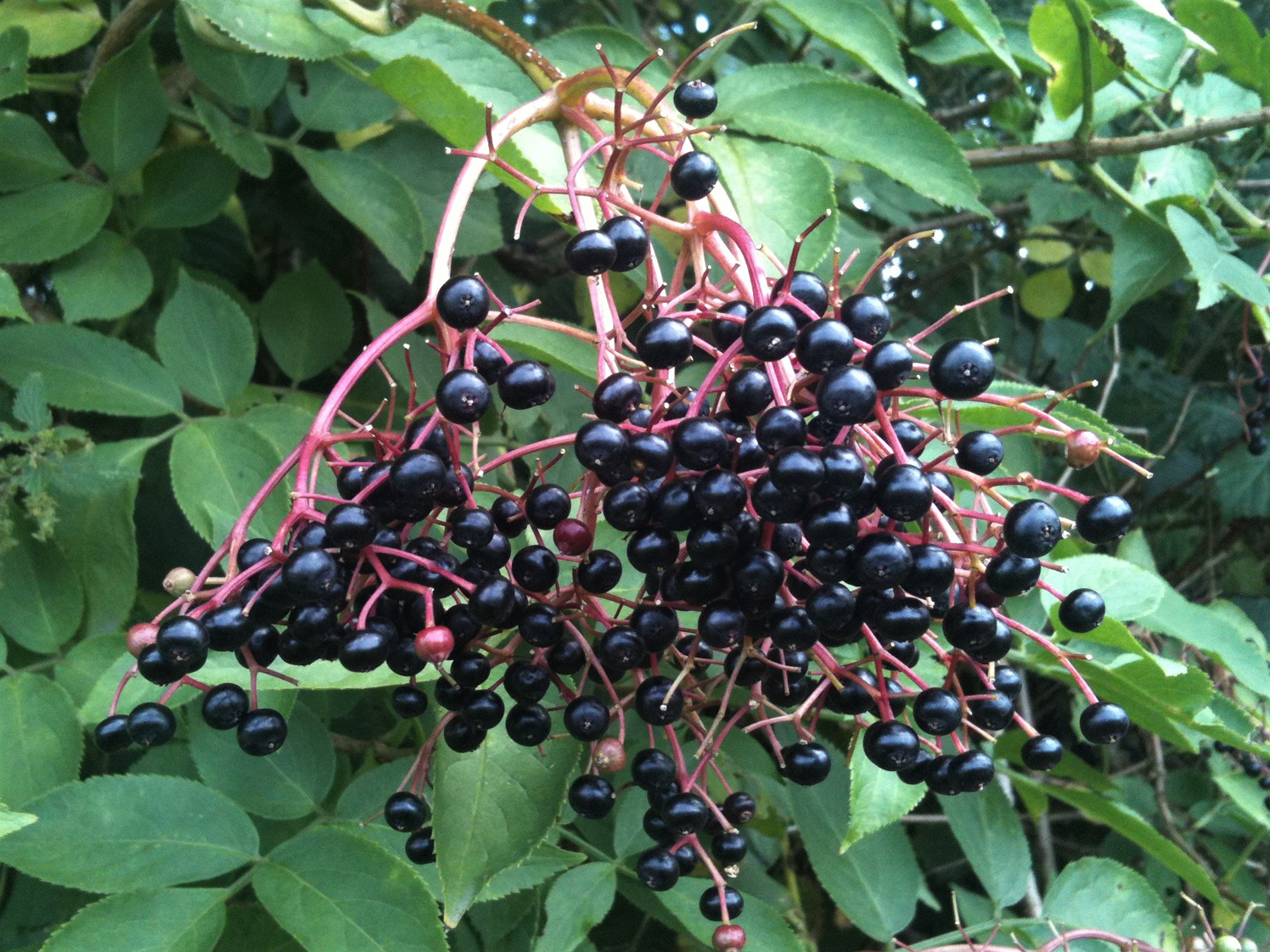Elderberry Balsamic Vinegar
Elderberries give this syrupy vinegar a lovely tart, fruity kick. Use it in place of regular balsamic in your recipes – it’s especially good in a salad dressing for the more bitter wild leaves like dandelion, primrose or oxeye daisy, but also good in marinades, to add sharpness to a rich stew, for macerating berries or as a sauce for pancakes or ice cream.
Makes : About 1 litre
Prep : 5days
Cook : 10minutes
- 500g ripe elderberries
- 750ml white wine or cider vinegar
- Granulated sugar (about 1kg)
Method
- Wash and drain the elderberries, then pick them from the umbels (a fork is a useful implement here), leaving as much of the stalk behind as possible. Use only the dark purple, ripe berries and discard the umbel stalks and any green unripe berries.
- Put the picked berries into a suitable container – a large non-reactive bowl or a large glass jar would be ideal – and pour over the vinegar. Cover the container and let the berries steep for 5 days, stirring once or twice a day.
- After then 5 days are up, strain the liquid through a seive. (You can, if you want, re-use the berries – see note below).
- Measure the vinegar (you should have about 750ml), and weigh out 325g sugar for every 250ml of strained liquid. (You can reduce the sugar for a sharper, more vinegary end result, but this ratio will give the tart-sweet finish of a typical balsamic vinegar).
- Pour the vinegar into a large pan and add the sugar. Set the pan over a low heat and gradually bring to the boil, stirring gently to dissolve the sugar. Simmer for 10 minutes, then remove the pan from the heat and pour the vinegar into sterilised bottles or jars.
Notes
The vinegar-soused berries are still packed with juice, so we suggest steeping them again in vinegar, adding spices to taste, and using the resulting infusion for marinades or dressings.



 (24 votes, average: 3.71 out of 5)
(24 votes, average: 3.71 out of 5)


11 comments for Elderberry Balsamic Vinegar
This is heading towards pontack sauce territory. We are currently using the 2017 vintage. Good things come to those who wait.
Thank you for the recipe. I will put it to good use and let you know about the finish product! 🌹
I made this recipe using cider vinegar about 3 months ago. I’ve just tried a bit to see how it’s coming along. it is very full in flavour. But the sweetness has overtaken the vinegar. Will maturing redress the balance?
Hi Isabella, thanks for commenting. The acidity of your base vinegar can vary greatly (as can personal taste – true balsamic is very sweet and syrupy, and not for everyone!). If your recipe has turned out too sweet, you might want to adjust the balance by adding more cider vinegar to it, until it is as sharp as you’d prefer. Maturing won’t really alter the sweetness level at this point.
Notes
The vinegar-soused berries are still packed with juice, so we suggest steeping them again in vinegar, adding spices to taste, and using the resulting infusion for marinades or dressings.
Is it OK to use the used berries in this way? On a forage course I thought we were told that they must be cooked
There are trace amounts of glycosides in the berries but not enough to cause any harm unless you were to eat bowls and bowls of them raw in one sitting. The glycosides are very unstable, I can’t be certain but I’m sure the vinegar would neutralise them, heat and alcohol do. It’s not scientific but I have eaten raw berries on many occasions and come to no harm.
Hi Gill – the idea is that you use the infused vinegar but you’d strain out the berries, so you wouldn’t be consuming them.
I soaked the berries in cider vinegar for 5 days and noticed a gooey staff built on the surface. Would you know what that could it be? Before I put some honey I have removed the gooey thing. The honey hasn’t given me the consistency of the balsamic unfortunately
Hi Alexandra, the gooey stuff was probably a clump of the natural yeasts and beneficial bacteria in the vinegar, often called the ‘mother’. It’s not harmful – in fact, it shows that the vinegar is ‘active’ – but it shouldn’t be consumed.
I don’t know if the honey is to blame for the vinegar not becoming syrupy – but the mixture might benefit from being heated again, until it has thickened to your liking. Hope this is helpful.
I am making my second batch, have had some great responses from people I have given it to. Is it necessary to use cheese cloth when straining, or is a wire mesh strainer good enough? And like a jelly bag, should the berries not be squeezed when straining?
It should be fine using a mesh strainer and pressing the berries through.